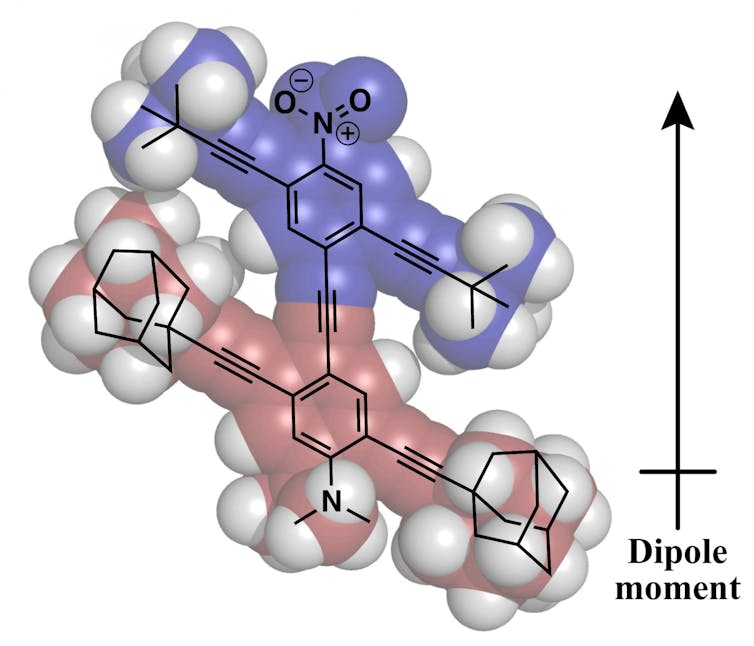Quantum dots are part of a revolution in engineering atoms in useful ways – Nobel Prize for chemistr
Quantum dots are a prime example of the way nanotechnology engineers materials at an atomic scale.

The 2023 Nobel Prize for chemistry isn’t the first Nobel awarded for research in nanotechnology. But it is perhaps the most colorful application of the technology to be associated with the accolade.
This year’s prize recognizes Moungi Bawendi, Louis Brus and Alexei Ekimov for the discovery and development of quantum dots. For many years, these precisely constructed nanometer-sized particles – just a few hundred thousandths the width of a human hair in diameter – were the darlings of nanotechnology pitches and presentations. As a researcher and adviser on nanotechnology, I’ve even used them myself when talking with developers, policymakers, advocacy groups and others about the promise and perils of the technology.
The origins of nanotechnology predate Bawendi, Brus and Ekimov’s work on quantum dots – the physicist Richard Feynman speculated on what could be possible through nanoscale engineering as early as 1959, and engineers like Erik Drexler were speculating about the possibilities of atomically precise manufacturing in the the 1980s. However, this year’s trio of Nobel laureates were part of the earliest wave of modern nanotechnology where researchers began putting breakthroughs in material science to practical use.
Quantum dots brilliantly fluoresce: They absorb one color of light and reemit it nearly instantaneously as another color. A vial of quantum dots, when illuminated with broad spectrum light, shines with a single vivid color. What makes them special, though, is that their color is determined by how large or small they are. Make them small and you get an intense blue. Make them larger, though still nanoscale, and the color shifts to red.

This property has led to many arresting images of rows of vials containing quantum dots of different sizes going from a striking blue on one end, through greens and oranges, to a vibrant red at the other. So eye-catching is this demonstration of the power of nanotechnology that, in the early 2000s, quantum dots became iconic of the strangeness and novelty of nanotechnology.
But, of course, quantum dots are more than a visually attractive parlor trick. They demonstrate that unique, controllable and useful interactions between matter and light can be achieved through engineering the physical form of matter – modifying the size, shape and structure of objects or instance – rather than playing with the chemical bonds between atoms and molecules. The distinction is an important one, and it’s at the heart of modern nanotechnology.
Skip chemical bonds, rely on quantum physics
The wavelengths of light that a material absorbs, reflects or emits are usually determined by the chemical bonds that bind its constituent atoms together. Play with the chemistry of a material and it’s possible to fine-tune these bonds so that they give you the colors you want. For instance, some of the earliest dyes started with a clear substance such as analine, transformed through chemical reactions to the desired hue.
It’s an effective way to work with light and color, but it also leads to products that fade over time as those bonds degrade. It also frequently involves using chemicals that are harmful to humans and the environment.
Quantum dots work differently. Rather than depending on chemical bonds to determine the wavelengths of light they absorb and emit, they rely on very small clusters of semiconducting materials. It’s the quantum physics of these clusters that then determines what wavelengths of light are emitted – and this in turn depends on how large or small the clusters are.
This ability to tune how a material behaves by simply changing its size is a game changer when it comes to the intensity and quality of light that quantum dots can produce, as well as their resistance to bleaching or fading, their novel uses and – if engineered smartly – their toxicity.
Of course, few materials are completely nontoxic, and quantum dots are no exception. Early quantum dots were often based on cadmium selenide for instance – the component materials of which are toxic. However, the potential toxicity of quantum dots needs to be balanced by the likelihood of release and exposure and how they compare with alternatives.

Since its earlier days, quantum dot technology has evolved in safety and usefulness and has found its way into an increasing number of products, from displays and lighting, to sensors, biomedical applications and more. In the process, some of their novelty has perhaps worn off. It can be hard to remember just how much of a quantum leap the technology is that’s being used to promote the latest generation of flashy TVs, for instance.
And yet, quantum dots are a pivotal part of a technology transition that’s revolutionizing how people work with atoms and molecules.
‘Base coding’ on an atomic level
In my book “Films from the Future: the Technology and Morality of Sci-Fi Movies,” I write about the concept of “base coding.” The idea is simple: If people can manipulate the most basic code that defines the world we live in, we can begin to redesign and reengineer it.
This concept is intuitive when it comes to computing, where programmers use the “base code” of 1,s and 0’s, albeit through higher level languages. It also makes sense in biology, where scientists are becoming increasingly adept at reading and writing the base code of DNA and RNA – in this case, using the chemical bases adenine, guanine, cytosine and thymine as their coding language.
This ability to work with base codes also extends to the material world. Here, the code is made up of atoms and molecules and how they are arranged in ways that lead to novel properties.
Bawendi, Brus and Ekimov’s work on quantum dots is a perfect example of this form of material-world base coding. By precisely forming small clusters of particular atoms into spherical “dots,” they were able to tap into novel quantum properties that would otherwise be inaccessible. Through their work they demonstrated the transformative power that comes through coding with atoms.

They paved the way for increasingly sophisticated nanoscale base coding that is now leading to products and applications that would not be possible without it. And they were part of the inspiration for a nanotechnology revolution that is continuing to this day. Reengineering the material world in these novel ways far transcends what can be achieved through more conventional technologies.
This possibility was captured in a 1999 U.S. National Science and Technology Council report with the title Nanotechnology: Shaping the World Atom by Atom. While it doesn’t explicitly mention quantum dots – an omission that I’m sure the authors are now kicking themselves over – it did capture just how transformative the ability to engineer materials at the atomic scale could be.
This atomic-level shaping of the world is exactly what Bawendi, Brus and Ekimov aspired to through their groundbreaking work. They were some of the first materials “base coders” as they used atomically precise engineering to harness the quantum physics of small particles – and the Nobel committee’s recognition of the significance of this is well deserved.
Andrew Maynard has previously received funding for nanotechnology-based work from the National Institutes of Health, the National Science Foundation, and the Pew Charitable Trusts
Read These Next
What’s at stake in Trump’s executive order aiming to curb state-level AI regulation
In the absence of comprehensive federal AI regulation, states have stepped in. The Trump administration,…
The Bible says little about Jesus’ childhood – but that didn’t stop medieval Christians from enjoyin
Legends about Jesus’ early years that circulated in medieval Europe often drew on apocryphal texts.
Data centers need electricity fast, but utilities need years to build power plants – who should pay?
How many data centers will be built – and how much electricity they’ll need – is uncertain. Being…





